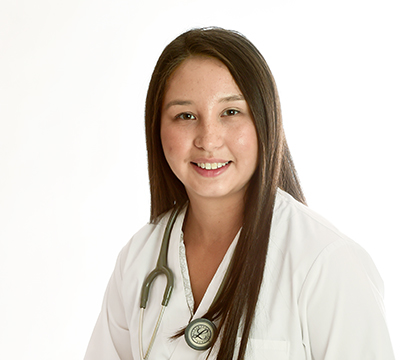
Manitoba student role model for community
When Samantha Bray found out that she'd been accepted as a veterinary student at the Western College of Veterinary Medicine (WCVM), her students at Winnipeg's Neeginan Learning and Literacy Centre celebrated along with her.
By Lynne Gunville
"When I announced to my students that I'd been accepted, they were all so proud of me," recalls Bray. "I think at that moment I took on a role model figure for them and hopefully inspired some of them to have big goals and try to achieve them."
Bray, who's a proud member of the Stellat'en First Nation, had worked with the centre's adult literacy program presenting information on topics that ranged from data collection to food production and traditional gardening methods.
She and the students also tested three different types of hydroponic systems as they grew edible vegetables for the centre's kitchen. They succeeded in growing large quantities of vegetables – results that could have a huge impact on northern remote communities that lack access to reasonably priced, fresh produce.
When Bray first began her undergraduate degree in biology at the University of Winnipeg (U of W), she was torn between human medicine and veterinary medicine. But she became focused on becoming a veterinarian once she witnessed her Jack Russell terrier Rosie giving birth to her first litter.
"My whole family was grossed out with the process, but I was there pulling them out, cutting umbilical cords, breaking open amniotic sacs and getting the puppies breathing," Bray says. "That was when I realized that I wanted to be a veterinarian."
Bray immediately set out to gain the experience and knowledge that would help her to reach that goal. In addition to volunteering at a veterinary clinic, she worked as a lab demonstrator in the animal physiology lab, and she focused her undergraduate classes and research on areas that would benefit her as a veterinary student.
She also worked as a summer student at the U of W Vivarium where she was responsible for the welfare of the experimental animals.
Bray's hard work paid off, and she's now a first-year student in the four-year Doctor of Veterinary medicine (DVM) program. She and her 77 classmates received an official welcome to the WCVM and to the veterinary profession on Friday, Sept. 23, during a white coat ceremony in Saskatoon, Sask.
The new students, who will graduate from the WCVM in 2020, come from communities across Western Canada and the northern territories.
When Bray looks back on her preparations for veterinary school, she's optimistic that her diverse background will help her as a student and a future clinician.
Whatever her future holds, is still focused on inspiring others: her primary goal is to provide veterinary services and animal welfare education to remote northern First Nations communities that don't have access to veterinary services.
"I hope to own my own mobile vet clinic and provide access to basic examinations and spay and neuters," says Bray. "I'd like to educate the community members on the importance of small animal welfare, and I want to help reduce the stray and feral dog populations through low-income/subsidized spay and neuter surgeries."
